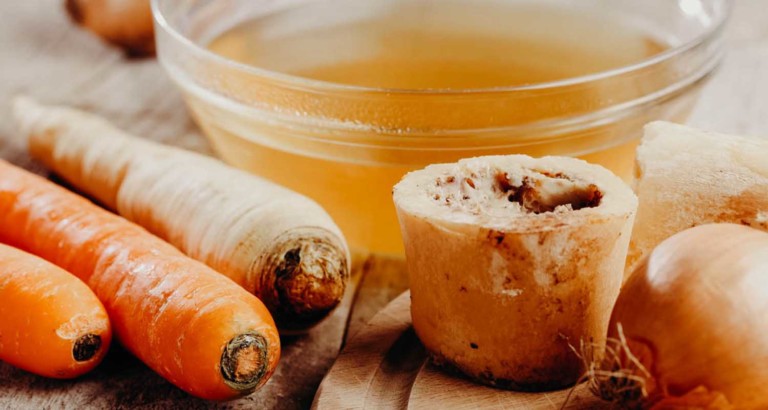
- Glyphosate, the active ingredient in Roundup, is a widely used and harmful herbicide used on crops and other plants to kill weeds.
- Glyphosate residue can be found in your food supply — on produce, in meat, and in packaged foods. Glyphosate in animals gets concentrated in collagen.
- Minimize your exposure to glyphosate by eating only organic foods and using only organic animal bones in your broth.
As the weather turns, there’s nothing better than cozying up with a mug of rich, delicious bone broth. (Get our bone broth recipe here.) A cup a day will help you reap the healing benefits of this excellent source of collagen — but may also be giving you a sneaky dose of glyphosate, a widely used, potentially cancerous herbicide.
Related: Collagen Can Make You Look and Feel Younger
The good news is, you can hugely reduce your exposure to glyphosate in food by eating an organic diet. Take a moment to clean up any broth you may have just spit out, then read on for a breakdown.
What is glyphosate?
Glyphosate, the active ingredient in Roundup, is the most widely used herbicide in the world, and poses a major health risk to consumers[ref url=”https://enveurope.springeropen.com/articles/10.1186/s12302-016-0070-0″] who unwittingly consume it in their food. Genetically-modified (GMO) crops such as “Roundup Ready” corn and soy are designed to be resistant to extreme doses of glyphosate, allowing farmers to spray billions of pounds each year to kill off weeds without killing their crops.
The research on the safety of glyphosate in food is plagued with dirty politics and conflicting studies, with Monsanto (the owner of Roundup) and other agriculture giants protecting their stakes in the outcome. You can read up on the glyphosate food controversy here, but the bottom line is: if you want to perform better, keep glyphosate out of your food.
Health risks of glyphosate in food
In May of 2015, the World Health Organization (WHO) classified glyphosate as “probably carcinogenic to humans,” based on their review of publicly available research. Human-specific studies on glyphosate exposure and cancer rates remain conflicting, with some studies showing correlation, and others finding none.[ref url=”http://www.thelancet.com/action/showFullTextImages?pii=S1470-2045%2815%2970134-8″][ref url=”https://www.ncbi.nlm.nih.gov/pmc/articles/PMC1253709″]
A study using human liver cells in vitro showed that even in low doses, glyphosate is toxic to human cells, causes genetic mutations, and disrupts endocrine function.[ref url=”http://www.sciencedirect.com/science/article/pii/S0300483X09003047″] Glyphosate’s role as an endocrine disruptor, as well as a factor in promoting oxidative stress, can also explain its cancer-promoting effects.[ref url=”http://www.sciencedirect.com/science/article/pii/S027869151530034X”] This was proven in a 2013 study, where glyphosate exposure caused breast cancer cells to proliferate in vitro, by mimicking estrogen.[ref url=”http://www.sciencedirect.com/science/article/pii/S0278691513003633″]
If there’s one thing glyphosate is great at, it’s killing anything not genetically engineered to resist it. Not only does it wreak havoc on soil biodiversity, it can also decimate your gut flora. Its antibiotic action, depletion of certain amino acids and minerals, and impairment of metabolic enzymes, is leading some researchers to investigate glyphosate as a direct cause of celiac disease.[ref url=”https://www.ncbi.nlm.nih.gov/pubmed/24678255″]
Where is glyphosate found?
The short answer? Pretty much everywhere. In 2014, farmers sprayed 1.65 billion pounds of glyphosate — that’s enough to cover every acre of our globe’s cropland in about half a pound of the chemical.[ref url=”https://www.ncbi.nlm.nih.gov/pubmed/25883837″] When you spray that much of anything into our environment, it comes down virtually everywhere. Even on a small, biodynamic farm that’s completely organic, there are still detectable levels of glyphosate in the ground.
That said, it’s a whole lot less than the amount of glyphosate found in any conventionally farmed food. Because spraying with glyphosate is prohibited in organic agriculture, people eating an organic diet have significantly lower glyphosate levels in their systems. It’s one reason the Bulletproof Diet recommends eating only organic food. If you’re doing Bulletproof on a budget, you can check the Environmental Working Group’s dirty dozen list to learn which conventional produce has the highest pesticide residue.
When you think of cutting out foods sprayed with glyphosate, it’s easy to overlook meats. After all, no one’s spraying down their cows with Roundup. But glyphosate has a tricky way of sticking around in animal proteins, and your bone broth just might be its ride.
Glyphosate in bone broth
Once it’s in your system, glyphosate accumulates most heavily in bones and collagen. This is because your body uses glyphosate indistinguishably from glycine, the most prevalent amino acid in collagen.[ref url=”https://people.csail.mit.edu/seneff/2017/SamselSeneff_Glyphosate_VI_final.pdf”] The same goes for animals raised on glyphosate-drenched GMO corn and soy. When you eat non-organic meat or collagen, you are incorporating significant amounts of glyphosate residues from whatever dose the animal ate.
Bone broth and collagen powder are proven ways to increase the collagen in your diet, but not so great if they’re served with a side of Roundup. To maximize your benefit, make sure your bones and collagen come from 100% grass-fed cows. Then head to our easy bone broth recipe to start sipping with confidence.
Read next:
Glyphosate: Why Eating Organic Food Really Does Matter











